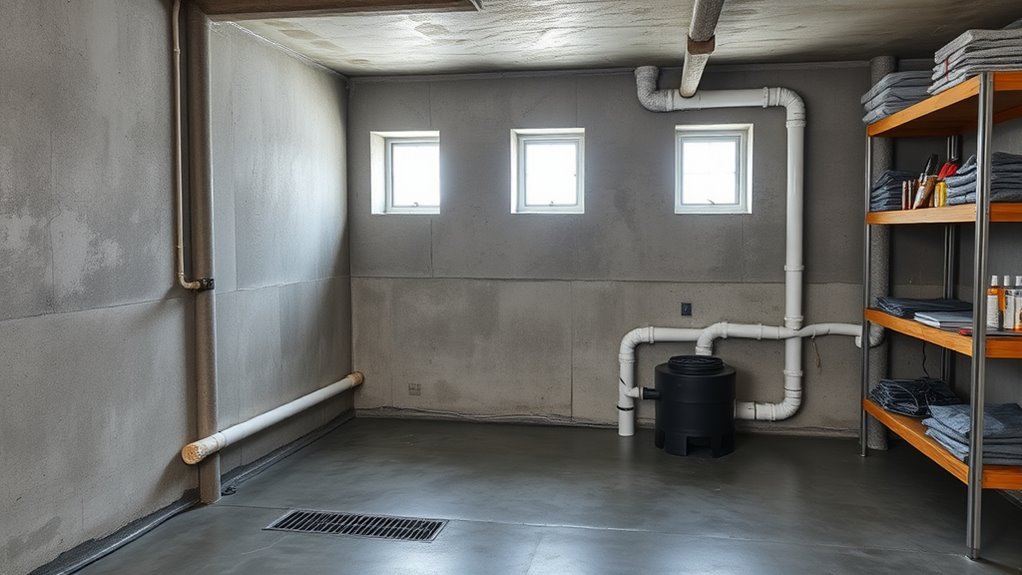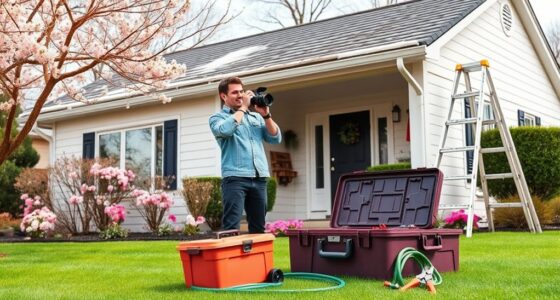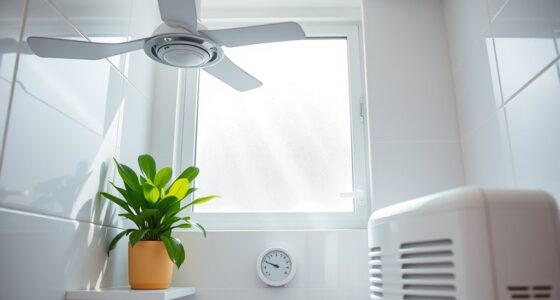As a new homeowner, understanding basement waterproofing is key to protecting your property. It involves preventing water from seeping in through cracks, poorly sealed windows, or inadequate drainage. Look for signs like water stains or musty odors and consider both interior and exterior solutions. Proper drainage systems, like sump pumps and gutters, also play an essential role. Continue exploring these basics to guarantee your basement stays dry and damage-free for years to come.
Key Takeaways
- Regularly inspect for signs of water stains, mold, or odors to catch issues early.
- Ensure proper exterior drainage, sealing cracks, and maintaining gutters to prevent water intrusion.
- Use interior solutions like vapor barriers, waterproof paints, and proper ventilation to reduce moisture buildup.
- Maintain sump pumps and drainage systems to effectively channel water away from your basement.
- Schedule professional assessments and waterproofing when persistent issues or mold growth are detected.
Understanding Why Waterproofing Matters
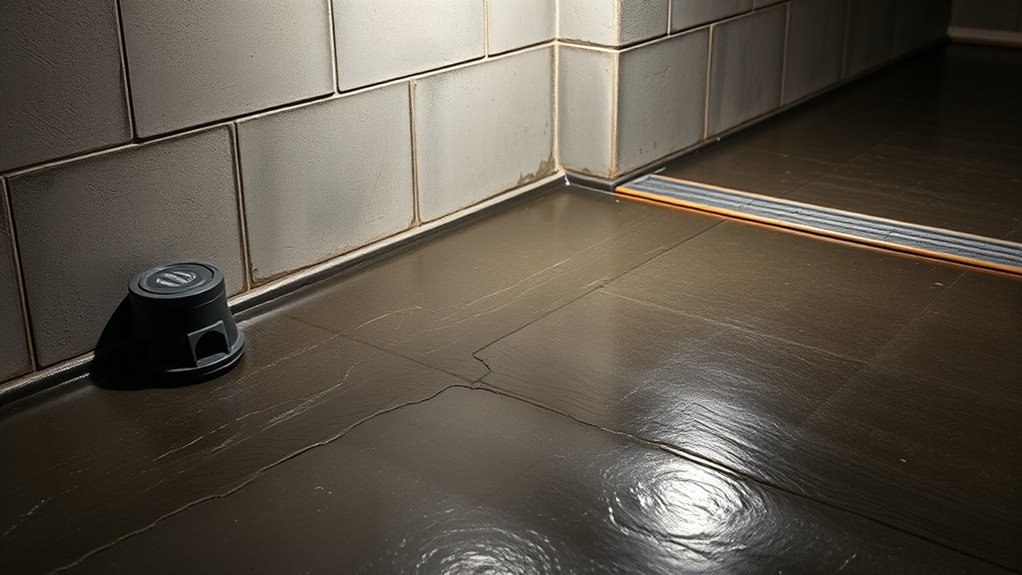
Waterproofing your basement is essential because it protects your home from water damage and structural issues. Proper basement ventilation helps prevent excess humidity, reducing the risk of mold and mildew growth that can weaken your foundation. Moisture barriers are key components of waterproofing, blocking water seepage through walls and floors. They create a protective layer that keeps moisture out, maintaining a dry environment inside. Without effective waterproofing, water can accumulate and cause deterioration, leading to costly repairs down the line. Understanding the importance of these elements helps you appreciate why waterproofing isn’t just about stopping leaks but about preserving your home’s integrity. Investing in good basement ventilation and moisture barriers ensures your space stays dry and structurally sound for years to come. Additionally, incorporating high-quality waterproofing materials can significantly enhance the effectiveness of your efforts, especially when selecting products designed for long-term durability.
Common Causes of Basement Water Intrusion
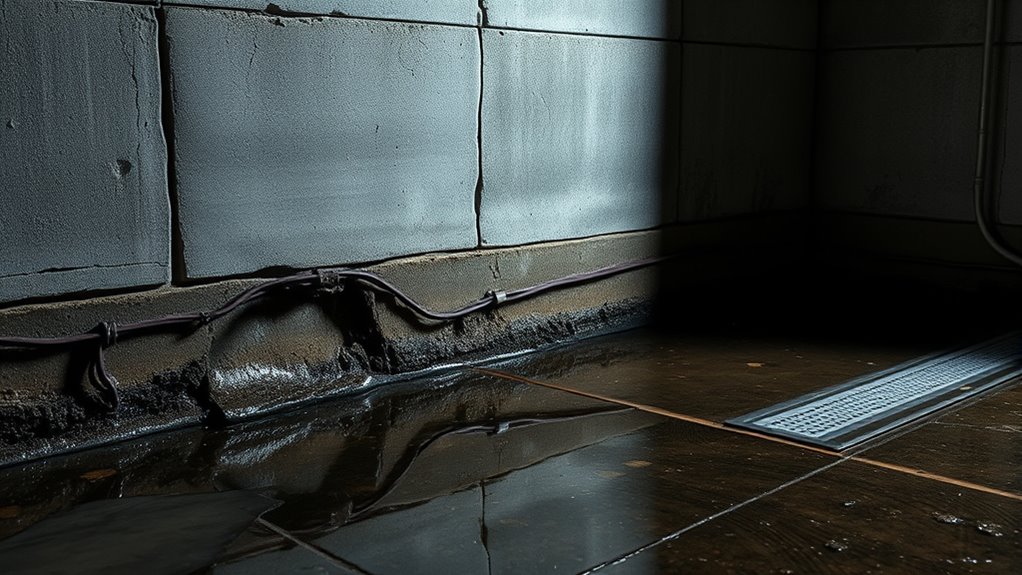
Understanding why waterproofing matters naturally leads to recognizing the common causes behind basement water intrusion. Poor basement ventilation can trap moisture, increasing humidity and creating ideal conditions for water seepage. Heavy rainfall or melting snow can overwhelm your drainage system, especially if gutters aren’t clear. A malfunctioning sump pump or neglecting sump pump maintenance can cause water to accumulate if it fails to remove excess groundwater effectively. Cracks in walls or floors also provide pathways for water to enter, especially during storms. Additionally, inadequate sealing around windows or pipes can let water seep in. Recognizing home environment factors that contribute to water intrusion helps you take targeted action to prevent damage and maintain a dry basement. Regular maintenance and proper ventilation are key to minimizing these common causes, as proper waterproofing techniques can significantly reduce the risk of water entry. Implementing effective drainage solutions around your property further enhances protection against water intrusion. Moreover, understanding waterproofing products can help you choose the best materials for long-term protection. Being aware of construction materials used in your basement can also influence waterproofing effectiveness and durability.
Signs Your Basement May Need Waterproofing
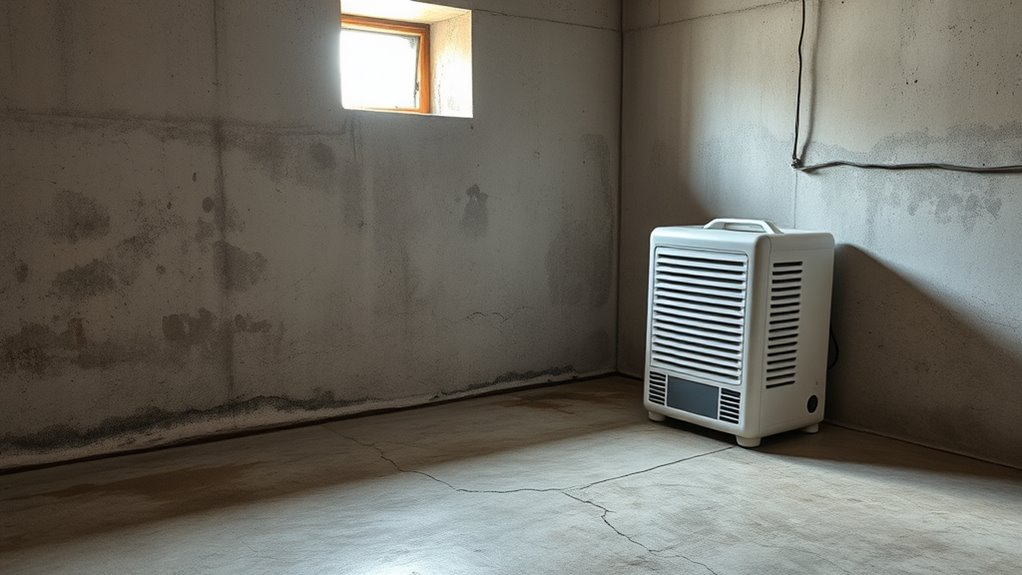
You might notice water stains on your basement walls or floors, which are clear signs of past or ongoing leaks. A persistent musty odor can also indicate mold or mildew growth caused by moisture. Recognizing these signs early helps you address waterproofing needs before the problem worsens. Additionally, waterproofing techniques can significantly prevent future water intrusion and protect your home’s foundation. Proper air quality management in the basement, including dehumidification and filtration, can also reduce humidity levels and inhibit mold growth, further safeguarding your living space. Implementing effective moisture control methods is crucial for maintaining a dry and healthy basement environment, especially in areas prone to heavy rainfall or humidity. Understanding air purifier technology and installing suitable units can help improve indoor air quality by removing allergens and reducing odors. Being aware of narcissistic traits in your home environment can help you establish healthy boundaries with difficult family members or neighbors.
Visible Water Stains
Visible water stains on your basement walls or floors are clear signs that moisture has penetrated your space, indicating a potential need for waterproofing. These stains often appear as discolored patches, rings, or streaks that don’t wash away. Water stain identification is vital because they reveal ongoing basement moisture issues that could worsen if left unchecked. Keep an eye out for brownish, yellow, or darker patches, especially near windows, corners, or areas with poor drainage. These stains may also be accompanied by peeling paint or efflorescence, further signaling water intrusion. Recognizing and acting on water stains ensures your basement stays dry and protected over time. Proper detection methods can help you assess the severity of the problem and determine the best waterproofing solutions. Additionally, understanding self watering plant pots and their moisture regulation can inspire effective ways to manage indoor humidity and moisture levels. Being aware of beach wave and wind dynamics can also inform how outdoor elements contribute to basement moisture issues, especially in coastal areas. Maintaining proper ventilation and drainage systems is crucial for preventing further water infiltration and protecting your home’s foundation. Regular inspections and using moisture meters can further aid in early detection and mitigation of basement water issues.
Musty Odor Presence
A persistent musty odor in your basement is a strong sign that moisture is lingering, and waterproofing may be necessary. This smell often indicates mold growth, which can compromise indoor air quality and damage your home. Addressing the odor early helps with mold prevention and reduces health risks. Moisture trapped in walls or floors creates an environment for mold spores to thrive, leading to ongoing odors. Waterproofing your basement can effectively mitigate these issues by sealing leaks and controlling humidity levels. If you notice this persistent smell, don’t ignore it—taking action now can prevent costly repairs later. Proper odor mitigation, combined with moisture control, keeps your basement dry, safe, and odor-free. Additionally, using appropriate dog names can help create a comfortable environment for your pets in your newly waterproofed space.
Types of Basement Waterproofing Methods
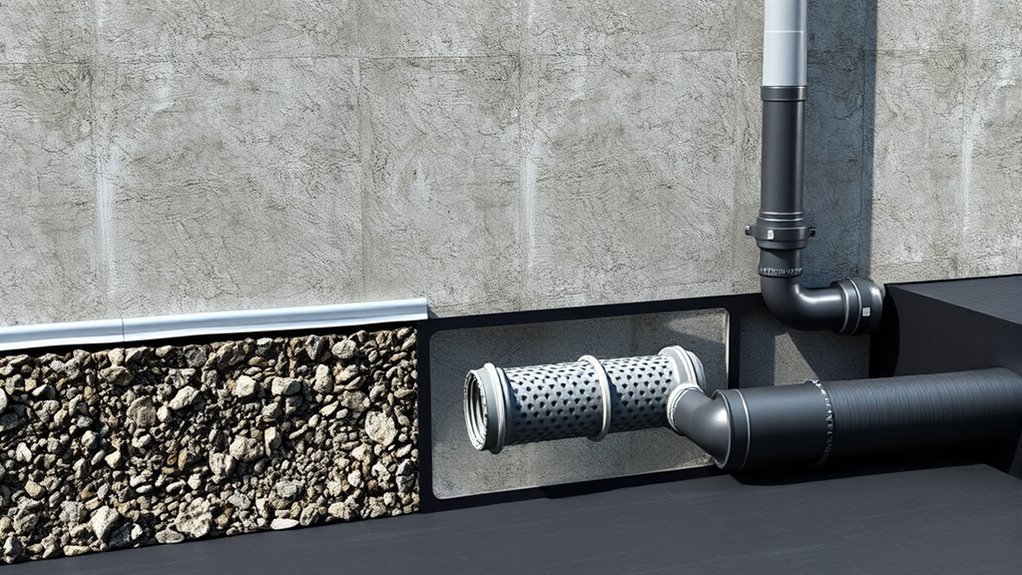
There are several effective methods to waterproof a basement, each suited to different types of leaks and building conditions. Exterior waterproofing involves applying moisture barriers and installing proper drainage systems outside your foundation, preventing water from seeping in. Interior solutions include basement insulation that controls humidity and moisture barriers that line interior walls to block water vapor. Sealants and coatings can be applied to interior walls to provide an extra layer of protection, especially against minor leaks. Drainage systems like sump pumps help remove water that manages to get inside. Choosing the right method depends on your specific situation, but combining exterior and interior approaches often offers the most extensive protection for your home. Properly applied, these methods keep your basement dry and protected from future water issues. Additionally, understanding the importance of foundation integrity can help prevent water intrusion issues before they begin. Implementing advanced waterproofing techniques can further enhance your home’s defenses against water damage, and consulting with professionals who are familiar with local building codes ensures that your waterproofing measures are compliant and effective.
Interior Waterproofing Solutions

Interior waterproofing solutions are essential for controlling moisture and preventing water damage from within your basement. Installing proper basement insulation helps regulate temperature and reduces condensation, which can lead to mold growth. Vapor barriers are vital for stopping moisture from seeping through walls and floors; they’re typically placed against interior surfaces to block vapor transmission. Sealing cracks and applying waterproof paints or coatings also form a moisture-resistant barrier. These solutions work together to keep the basement dry, protect stored items, and improve air quality. Regular maintenance of insulation and vapor barriers will ensure your basement stays dry and structurally sound over time. Additionally, using quality dyes and sealants during installation can enhance the effectiveness and longevity of your waterproofing efforts. Incorporating proper ventilation can further reduce humidity levels and prevent mold development, ensuring a healthier basement environment.
Exterior Waterproofing Strategies
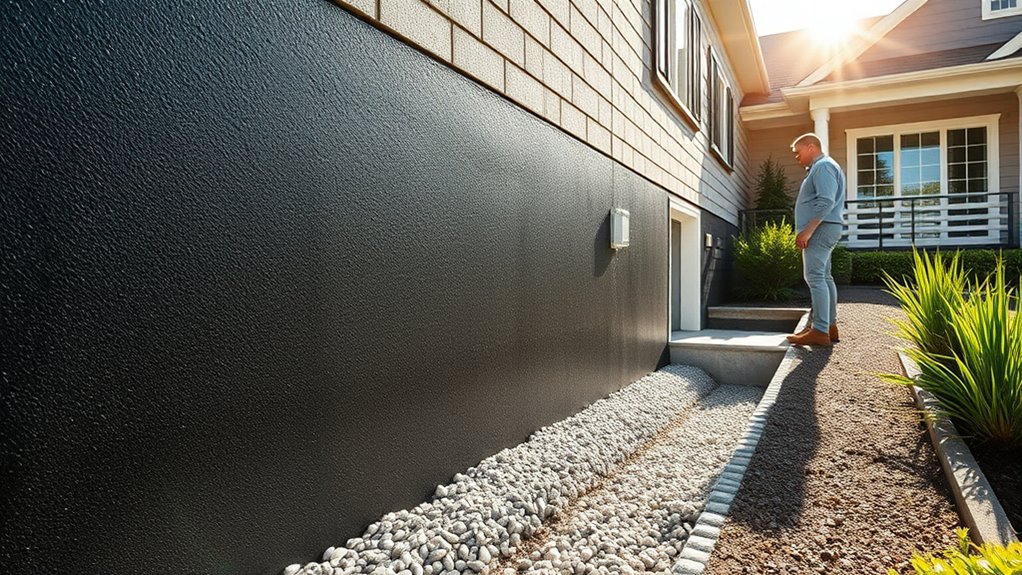
To protect your basement from water intrusion, you need to focus on exterior waterproofing strategies. Ensuring proper drainage systems, applying effective waterproof coatings, and maintaining gutters and downspouts are essential steps. These measures work together to keep water away from your foundation and prevent leaks.
Proper Drainage Systems
Proper drainage systems are essential for effective exterior waterproofing because they direct water away from your foundation before it can cause damage. A well-designed system prevents water buildup and reduces pressure on your basement walls. Here are three key components:
- French drain – a perforated pipe installed underground that channels water away from your home.
- Sump pump – a device that removes accumulated water from your basement or crawlspace, especially during heavy rain.
- Proper grading – ensuring the soil slopes away from your foundation to encourage runoff.
Using these strategies, you can effectively manage water flow, minimize hydrostatic pressure, and protect your basement from flooding and moisture intrusion. Proper drainage systems form the foundation of a successful waterproofing plan.
Effective Waterproof Coatings
While effective drainage systems keep water from reaching your foundation, applying durable waterproof coatings on exterior surfaces adds a vital layer of protection. These coatings seal cracks and pores, preventing water seepage and reducing the risk of basement flooding. Before applying coatings, ensure your basement insulation is properly installed—this helps control moisture levels and enhances overall waterproofing. When considering exterior waterproofing, also evaluate your sump pump selection; a reliable sump pump works with these coatings to divert water away from your foundation effectively. Use high-quality, elastomeric or bituminous coatings designed for outdoor use, and follow manufacturer instructions carefully. Together, these measures create a strong barrier against water intrusion, increasing your home’s durability and protecting your basement from future water damage.
Gutter and Downspout Maintenance
Regularly inspecting and maintaining your gutters and downspouts is essential for effective exterior waterproofing. If your rain gutter or downspout isn’t functioning properly, water can pool around your foundation, increasing the risk of basement leaks. To keep things in check:
- Clean out debris from your rain gutter and downspouts to prevent clogs.
- Ensure downspouts direct water at least 3-4 feet away from your foundation using downspout extensions.
- Check for leaks or damage, and repair or replace parts as needed to maintain proper flow.
The Role of Proper Drainage Systems
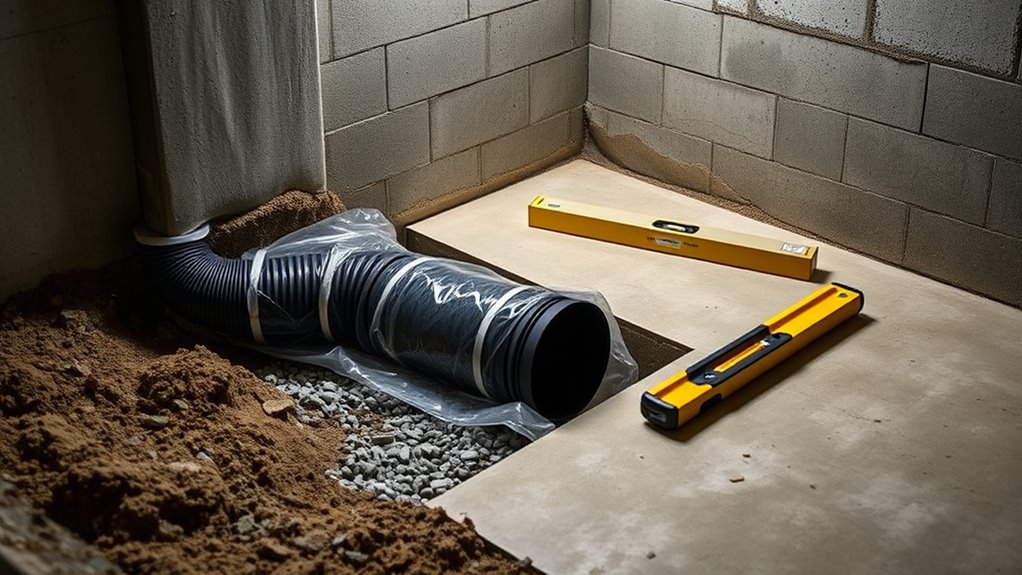
Effective drainage systems are essential for preventing water from seeping into your basement. Proper drainage helps direct rainwater away from your home’s foundation, reducing pressure and potential leaks. Incorporate garden landscaping techniques, such as grading your yard to slope away from the house, to improve water runoff. Installing effective gutters and downspouts also plays a critical role in directing water to appropriate drainage areas. Additionally, a well-designed drainage system supports foundation reinforcement by minimizing water exposure that can weaken your basement walls. Without proper drainage, water can accumulate around your foundation, leading to leaks and structural issues. Regularly maintaining these systems ensures water flows where it should, protecting your basement and enhancing your home’s overall stability.
DIY Waterproofing Tips for Homeowners
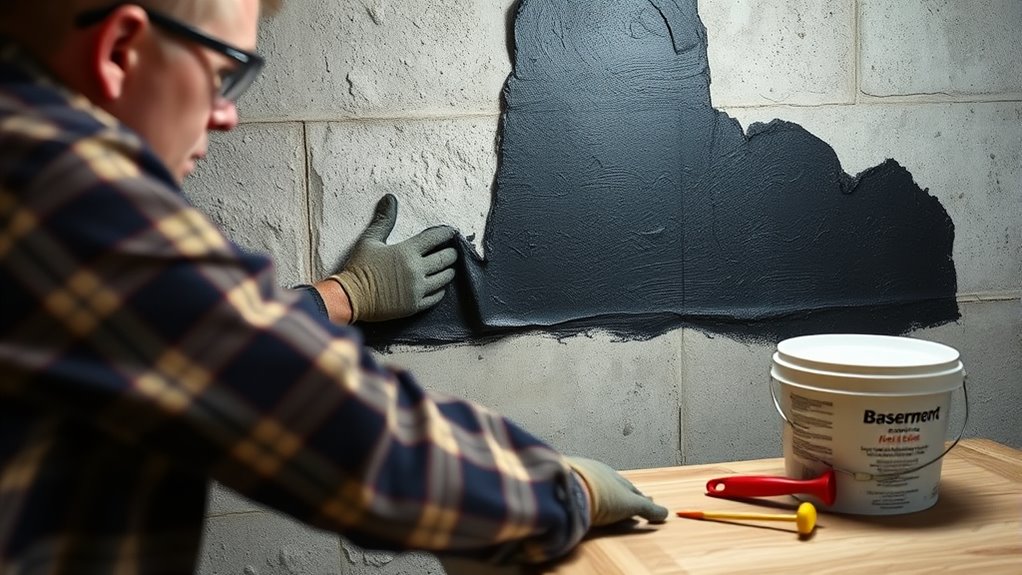
To keep your basement dry, start by sealing any cracks you find with waterproof sealant to prevent water intrusion. Next, check your drainage systems and make improvements if needed to direct water away from your foundation. Taking these simple steps can make a big difference in protecting your home from water damage.
Seal Cracks Effectively
Cracks in your basement walls or floors can quickly lead to water seepage if left unsealed. To prevent damage, focus on effective crack sealing. First, clean out the crack thoroughly, removing loose debris and dust. Next, apply a high-quality epoxy or polyurethane sealant designed for foundation repairs, pressing it firmly into the crack. Finally, smooth out the sealant to ensure it’s flush with the wall or floor surface, preventing water from seeping in. Remember, timely crack sealing protects your home’s foundation and keeps moisture out. For larger or persistent cracks, consulting a professional may be necessary to ensure proper foundation repairs. Regularly inspecting and sealing cracks can save you costly repairs later and maintain a dry, stable basement.
Improve Drainage Systems
Improving your drainage system is a crucial step in preventing basement water issues. Start by conducting permeability testing around your foundation to identify areas where water easily seeps through soil. This helps determine the best solutions for managing excess moisture. Next, focus on drainage pipe selection; choose perforated pipes designed for proper water flow and durability. Properly installed drainage pipes direct water away from your foundation, reducing pressure buildup and leaks. Make sure the pipes are connected to a reliable sump pump or drainage system to handle heavy rainfall. Regularly inspect and clean your drainage components to maintain peak function. By testing permeability and selecting the right drainage pipes, you markedly lower your chances of basement flooding and long-term water damage, creating a safer, drier home.
When to Hire Professional Waterproofing Services
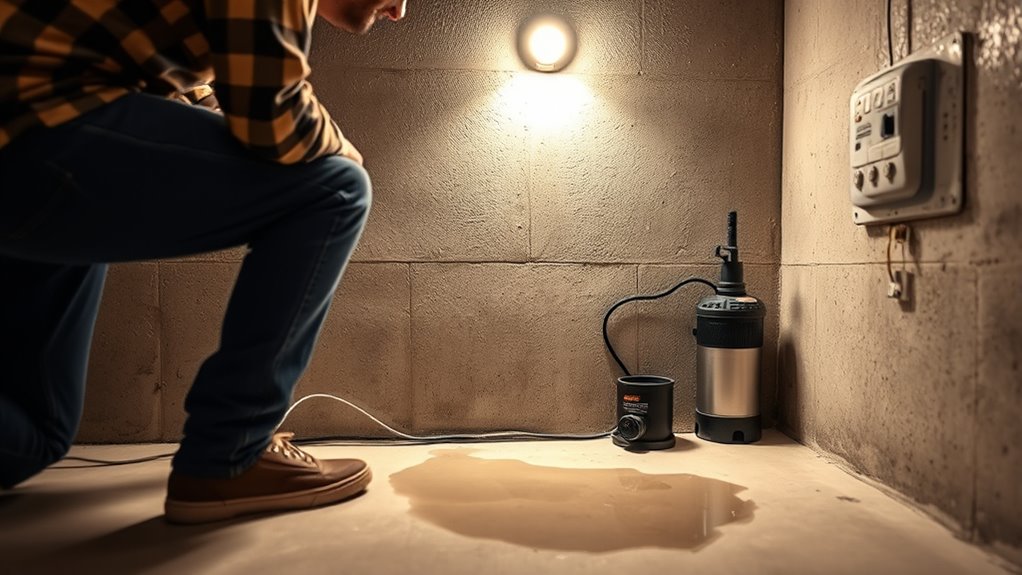
Knowing when to hire professional waterproofing services can save you from costly repairs down the line. If you notice persistent dampness or water stains despite your efforts, it’s time to call in experts. Consider hiring professionals if:
- You see mold or musty odors that won’t go away, impacting your basement lighting and overall air quality.
- Your basement floods regularly, especially after heavy rain, indicating drainage or foundation issues.
- You’re planning garden landscaping near your foundation, which could disturb existing waterproofing, or if you want to ensure your basement remains dry before installing new lighting fixtures.
Professionals can assess your system, address leaks, and help you make informed decisions about landscaping or lighting setups that won’t compromise waterproofing.
Maintaining a Waterproofed Basement Over Time
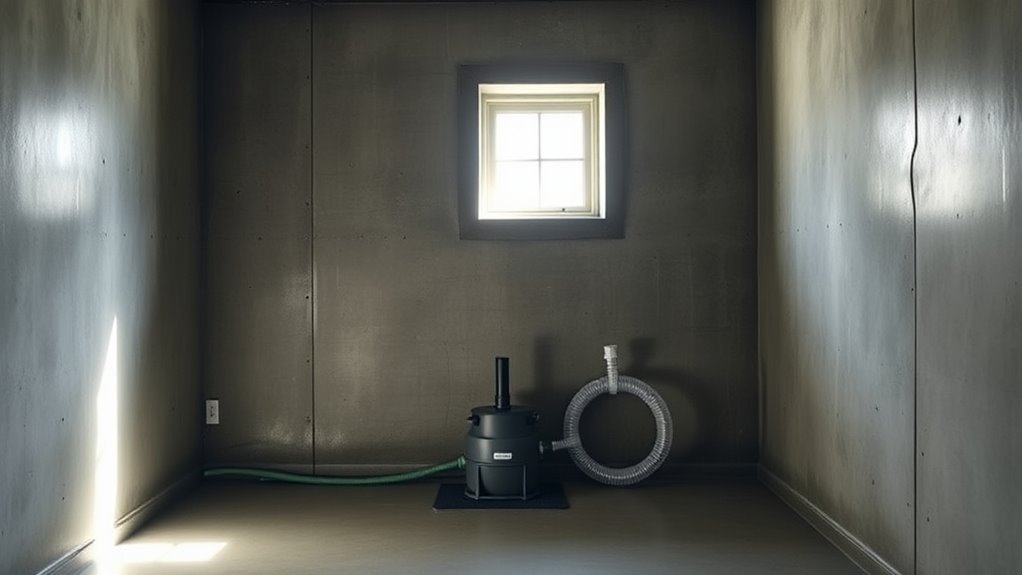
Once you’ve invested in professional waterproofing, ongoing maintenance is essential to keep your basement dry and protected. Regularly inspect your basement for signs of moisture, mold, or cracks, and address issues promptly. Proper basement ventilation helps reduce humidity, preventing mold growth and maintaining air quality. Keep gutters and downspouts clear to direct water away from your foundation. Review your waterproofing warranties annually to ensure coverage remains valid and to understand any maintenance requirements. If your waterproofing system includes sump pumps or drainage systems, test them periodically to confirm they’re functioning correctly. Consistent upkeep not only preserves your investment but also extends the lifespan of your waterproofing efforts, ensuring your basement stays dry and healthy for years to come.
Frequently Asked Questions
How Long Does Basement Waterproofing Typically Last?
Your basement waterproofing can last anywhere from 10 to 30 years, depending on maintenance and conditions. Proper drainage systems and moisture barriers play a vital role in longevity. Regular inspections help catch issues early, ensuring your waterproofing remains effective. Over time, wear and tear may require repairs or upgrades, but with proper care, your basement stays dry and protected for many years to come.
What Are the Costs Associated With Professional Waterproofing?
Imagine sealing a leaky boat before a storm—professional waterproofing costs vary like the size of the leak. On average, you might spend between $2,000 and $6,000, depending on the size and condition of your basement. Consider service warranties, which can offer peace of mind and savings down the line. Your investment ensures your home stays dry, and upfront cost estimates help you plan effectively for this vital project.
Can Waterproofing Increase My Home’s Value?
Waterproofing can boost your home’s value by enhancing foundation repair and moisture control. When you invest in proper waterproofing, it makes your home more attractive to buyers, as they see a well-maintained, durable foundation. Plus, it reduces future repair costs, giving them peace of mind. Overall, waterproofing not only preserves your home’s integrity but also adds to its market appeal, making it a smart investment for increasing value.
Are There Eco-Friendly Waterproofing Options?
You might think waterproofing is all about harsh chemicals, but there are eco-friendly solutions that blow that idea away! Using sustainable materials, you can protect your basement while saving the environment. These innovative options are just as effective, if not more, than traditional methods. By choosing eco-friendly solutions, you’re making a smart, green choice that benefits your home and our planet—no harsh chemicals required!
How Do I Choose the Right Waterproofing Contractor?
When choosing a waterproofing contractor, you should look for qualified professionals with proper certifications and experience. Ask about their Contractor qualifications to make certain they’re skilled and reliable. Additionally, verify that they offer waterproofing warranties, which protect you if issues arise later. Getting multiple quotes, checking references, and reviewing past work helps you select a trustworthy contractor who guarantees quality and peace of mind.
Conclusion
By understanding the basics of basement waterproofing, you’re arming yourself against water’s sneaky ways. Think of your basement as a fortress—regular maintenance and timely repairs keep it strong. Don’t let water seep in like uninvited guests; instead, stay vigilant and proactive. With the right methods and a little effort, you’ll prevent trouble before it starts, turning your basement into a dry, welcoming space. After all, a dry basement is the foundation of a happy home.

